Exhibitions 1
Elisabeth Vellacott (Piers Feetham Gallery, 475 Fulham Road, SW6, till 4 November)
Drawing on experience
Michael Glover
The East Anglian artist Elisabeth Vel- lacott manages to combine two quite dis- tinctive talents: that of drawer and that of painter. Her paintings, imaginatively exu- berant, mannered and somewhat theatri- cally naive in their representation of the human figure, are eagerly collected. Her chaste and classicising drawings — of rock formations, woodland, plants and flowers, all close-worked, concentrated and meticu- lously attentive to the smallest detail — are less well-known.
In the 1920s Vellacott studied at the Royal College of Art alongside Cecil Collins and Eric Ravilious. Despite learn- mg much from her drawing tutor, Tom Monnington, the RCA was a touch too stiffly academic for her taste. It was to the nearby V&A that she would go for emo- tional and artistic sustenance. The flat planes of glowing colour that she saw in a famous show of Russian icons at the V&A would help to form her style as a mature painter. After the RCA came textile designing — it was this which rid her sys- tem of any desire to become an abstract painter, she once remarked — and, in the early 1930s, she worked with Lilian Baylis designing theatre sets at the Old Vic for a pittance.
In 1939 she was invited to do some deco- rative frescos in the old Manor House at Hemingford Grey near Cambridge. Her new friendship with its then owner, the children's writer Lucy Boston, developed into a life-long attachment, and in the later 1950s Elisabeth Vellacott built a house for herself in the orchard of the manor house. There she has lived and worked ever since, though the orchard, alas, is no more.
Vellacott reached maturity as an artist fairly late in her long life (she is now 95 years old): her first one-woman show did not take place until she had passed her 60th year. The drawings in this exhibition span a period of about 30 years, from the 1950s to the 1980s, and many of them are visual records of the trips she made to Wales, Scotland and the Scilly Isles. And there are still-lives: chryanthemums in a vase; still-life with plant stems. The most dramatic drawings are the renderings of rock formations in Anglesey and Cornwall, some robust and monumental in pen and wash, others, the more ghostly, in soft pencil, slightly and teasingly obscured by a fine slanting rain. But the most beautiful work of all is a trio of drawings of woodland and trees hanging over water.
For many years Elisabeth Vellacott had a postcard reproduction of Uccello's cele- brated 'Hunt in the Forest at Night' pinned to the wall of her studio, and it is the subtle density and sheer complexity of woodland that bring out the best in her.
People on a Hilltop, by Elisabeth Vellacott

























































































 Previous page
Previous page